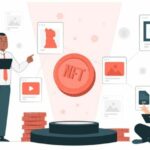A guide on Non-Fungible Tokens (NFTs) and an explanation to why some are worth Millions
What is a non-fungible token?
In financial aspects, a fungible resource is something with units that can be promptly traded – like cash.
With cash, you can trade a £10 note for two £5 notes and it will have a similar worth.
In any case, in case something is non-fungible tokens, this is inconceivable – it implies it has one of a kind properties so it can’t be traded with something different.
It very well may be a house, or a work of art, for example, the Mona Lisa, which is exceptional. You can snap a picture of the canvas or purchase a print however there will just at any point be one unique painting.
NFTs are “unique” resources in the digital world that can be purchased and sold like some other piece of property, yet which have no substantial type of their own.
The digital tokens can be considered as endorsements of possession for virtual or actual resources.
How do NFTs work?
Customary show-stoppers, for example, artistic creations are important unequivocally in light of the fact that they are exceptional.
In any case, digital records can be effectively and interminably copied.
With NFTs, work of art can be “tokenised” to make a digital authentication of possession that can be purchased and sold.
Also Read:
The records can’t be produced in light of the fact that the record is kept up with by great many PCs all throughout the planet.
NFTs can likewise contain brilliant agreements that might give the craftsman, for instance, a cut of any future offer of the token.
What amount are NFTs worth?
In principle, anyone can tokenise their work to sell as a NFT however premium has been fuelled by late features of multi-million-dollar deals.
On 19 February, an energized Gif of Nyan Cat – a 2011 image of a flying pop-tart feline – sold for more than $500,000 (£365,000).
Half a month after the fact, artist Grimes sold a portion of her digital craftsmanship for more than $6m.
It isn’t simply workmanship that is tokenised and sold. Twitter’s author Jack Dorsey has advanced a NFT of the very first tweet, with offers hitting $2.5m.
Christie’s offer of a NFT by digital craftsman Beeple for $69m (£50m) set another standard for digital workmanship.
French firm Sorare, which sells football exchanging cards the type of NFTs, has raised $680m (£498m).
However, as with digital forms of money, there are worries about the ecological effect of keeping up with the blockchain.
‘Side-peering toward Chloe’ Clem to sell famous image as NFT
What’s halting individuals replicating the digital workmanship?
Nothing. A great many individuals have seen Beeple’s specialty that sold for $69m and the picture has been replicated and shared on many occasions.
As a rule, the craftsman even holds the copyright responsibility for work, so they can proceed to deliver and sell duplicates.
In any case, the purchaser of the NFT claims a “token” that demonstrates they own the “first” work.
Certain individuals contrast it with purchasing a signed print.
Is this an air pocket?
A day prior to his record-breaking closeout, Beeple – whose genuine name is Mike Winkelmann – told the BBC: “I really think there will be an air pocket, to be very fair.
“What’s more, I figure we could be in that air pocket at the present time.”
Many are much more incredulous.
David Gerard, creator of Attack of the 50-foot Blockchain, said he considered NFTs to be purchasing “official collectables”, like exchanging cards.
“There are a few specialists totally making bank on this stuff… it’s simply that you most likely will not,” he cautioned.
Individuals really selling the NFTs are “crypto-swindlers”, he said.
“Similar folks who’ve consistently been busy, attempting to think of another type of useless sorcery bean that they can sell for cash.”
Previous Christie’s barker Charles Allsopp said the idea of purchasing NFTs made “no sense”.
“Purchasing something which isn’t there is simply odd,” he told the BBC.
“I think individuals who put resources into it are slight mugs, yet I trust they don’t lose their cash.”
Also Read:
Can Non Fungible Tokens be a bigger deal than Cryptocurrency?
Source: https://www.bbc.com/news/technology-56371912


